Archivio
-
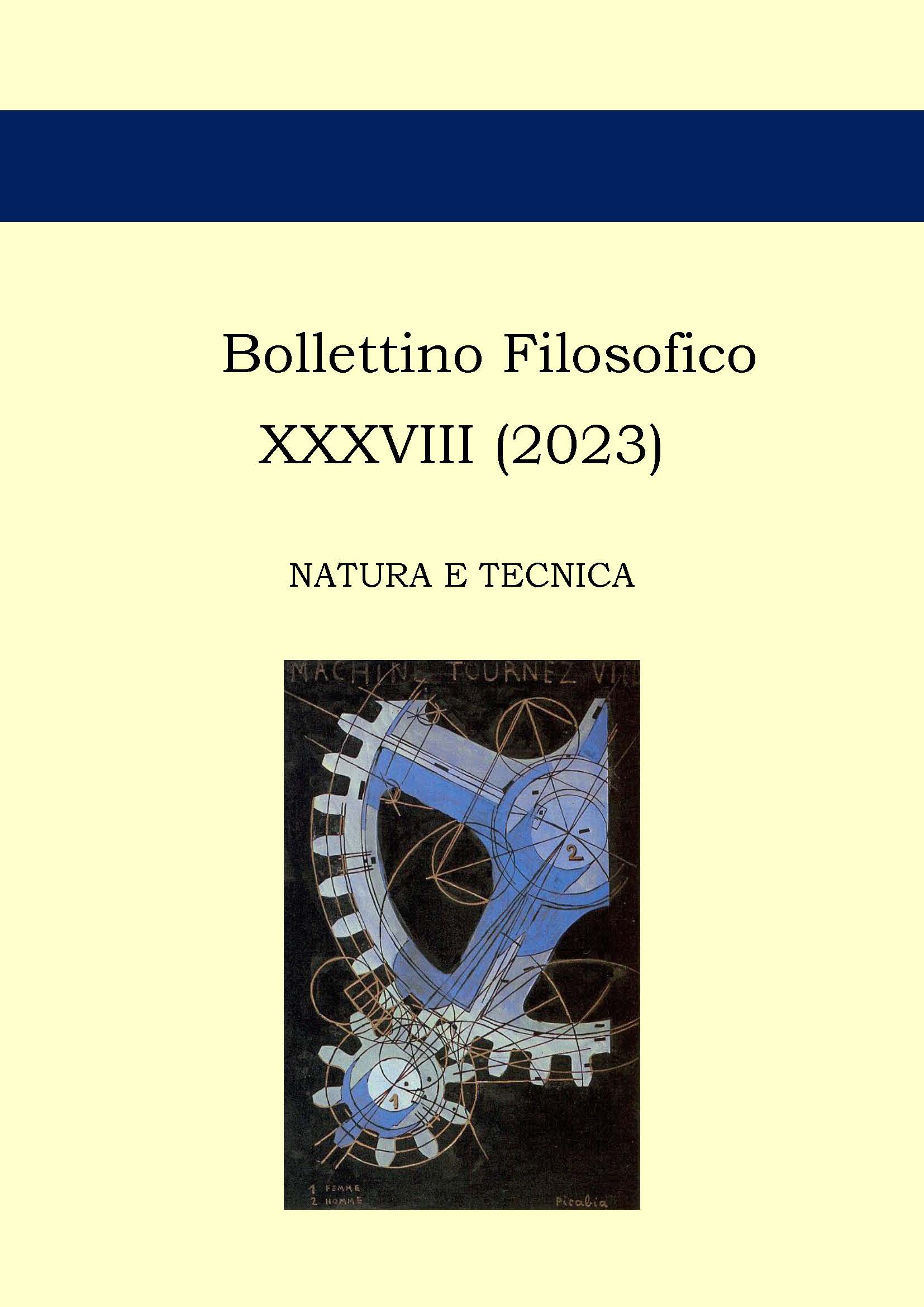
NATURA E TECNICA
V. 38 (2023)Dall’Introduzione: «Quanto siamo distanti dal 1954 quando Heidegger pubblicò il pioneristico Die Frage nach der Technik? E quanto siamo lontani da quell’analisi che radicava in una peculiare, ma certo non poco chiara né poco argomentata, comprensione di physis? Ma quanto ci separa anche dai primi studi sulla biopolitica e sulla fine del tempo in cui la vita era un fatto indiscusso e l’inizio di un’epoca in cui diventa argomento di discussione e oggetto di ingegneria sociale o di emancipazione?
L’attuale letteratura filosofica è ricca di posizioni e di proposte che solo in rari casi dedicano pari attenzione ai due termini del nostro rapporto. La riscoperta della paleoantropologia, antropologicamente informata di Leroi-Gourhan, gli sviluppi dell’etologia dopo Lorenz, la rinascita dell’interesse per Simondon, ma anche il neoheideggerismo, la post-fenomenologia di Ihde e Veerbek, la diffusione degli SST con Latour e Ingold, ne sono solo alcuni esempi a cui si affiancano le tendenze ecologiste profonde dell’Ontologia orientata agli oggetti di Harman o Morton.
Su questi temi si è concentrato il Secondo Convegno della SIFiT, che si è tenuto nell’ottobre 2021 a Napoli e di cui questo numero del Bollettino Filosofico pubblica gli interventi, ampiamente rivisti anche a seguito della vivace discussione che essi alimentarono. In coerenza col formato della rivista, i saggi sono divisi in due sezioni, Focus e Forum, che corrispondono grossomodo rispettivamente alle conferenze e alle sessioni parallele che ebbero luogo durante il convegno».
-
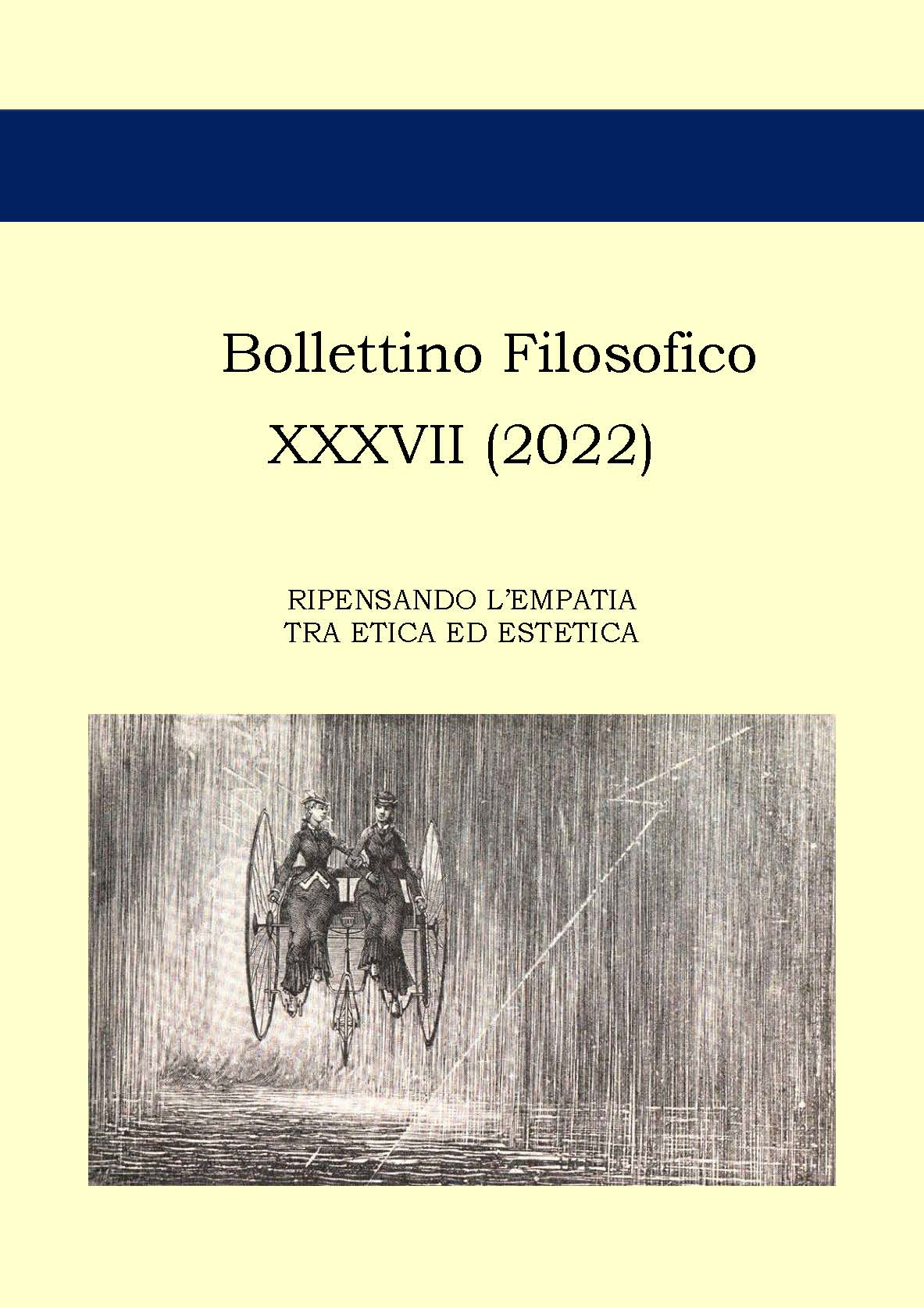
Ripensando l'empatia. Tra etica ed estetica
V. 37 (2022)RIPENSANDO L’EMPATIA. TRA ETICA ED ESTETICA
Il concetto di empatia nasce sul terreno dell’estetica grazie allo storico e filosofo dell’arte Robert Vischer che, nel 1873, utilizza per la prima volta il termine Einfühlung, riferendosi alla tendenza di un osservatore a proiettare i propri stati emotivi sull’oggetto osservato. Il primo a trasferire il concetto di “empatia” sul piano della relazione intersoggettiva fu Theodor Lipps, che sostituì al concetto di proiezione quello di “partecipazione emotiva” resa possibile da una sorta di “imitazione interna” (innere Nachahmung) dei movimenti dell’altro. Tra i primi a cogliere l’ambiguità del concetto di empatia fu Husserl, il quale, pur definendolo “un enigma oscuro e addirittura tormentoso”, gli dedicò grande attenzione, come si evince soprattutto dai manoscritti di lavoro. Successivamente, il concetto di empatia è stato ampiamente indagato in ambito fenomenologico – basti pensare a Moritz Geiger, Edith Stein o a Max Scheler – mantenendo sempre ferma l’esigenza di riconoscere nella relazione la radicale alterità dell’altro ed evitando i rischi connessi alla confusione dei vissuti, che può divenire indistinzione o addirittura “unipatia”. Ma la Einfühlung, divenuta concetto centrale per spiegare la paradossale relazione con l’alter, rischia comunque di rimanere sospesa tra i problemi connessi al contagio emotivo e quelli propri di un processo cognitivo e intellettuale, come quello richiesto dalle teorie dell’analogia. Si tratta, dunque, di un giro lungo che, passando per l’inferenza analogica, riduce l’impatto con l'alterità, risolvendosi in un affondo introspettivo, solo successivamente piegato all’esteriorità. Da qui si apre anche un ulteriore ambito problematico che riguarda la costellazione di concetti del vissuto empatico, lungo l’asse teorico che va dalle analisi protofenomenologiche del giovane Jaspers all’antropoanalisi esistenziale di Ludwig Binswanger. Nel corso del Novecento, il pensiero filosofico ha variamente ripreso e modulato la feconda intuizione di Lipps e il dibattito sull’empatia si è sviluppato fino a produrre un vero e proprio “empathic turn” che, anche grazie alla scoperta dei “neuroni specchio”, ha ampiamente influenzato la riflessione estetica contemporanea. Il concetto di “simulazione incarnata”, uno dei cardini di queste ricerche, radicalizzando l’intuizione di Lipps, si presenta infatti come una ulteriore critica dell’inferenza analogica, a favore di un coinvolgimento immediato. Oggi, il dibattito sull’empatia e sul rapporto tra empatia e esperienza estetica, da un lato e tra empatia e etica, dall’altro, è uno dei più accesi, anche in virtù del suo coinvolgere ambiti di riflessione diversi ma contigui, come, ad esempio: il rapporto identità-diversità, individuo-comunità, soggettivazione-alterità, nonché arte-emozione, realtà e finzione, creazione e fruizione estetica, espressività e tecnica. Per semplificare si possono individuare due linee teoriche. La prima, che potremmo definire “naturalistico-riduzionista”, ritiene che attraverso i meccanismi neurologici si possa spiegare la totalità dell’esperienza empatica che diventerebbe così il fondamento sia dell’esperienza estetica sia di quella etica; la seconda, invece, più squisitamente “filosofica”, pur riconoscendo l’importanza di un’indagine scientifica che ci consenta di comprendere il nostro rapporto immediato con l’oggetto (inteso anche come altro io), rivendica il ruolo della riflessione filosofica nella comprensione dei processi patici, cognitivi e riflessivi che ci consentono di entrare in relazione con l’altro.
-
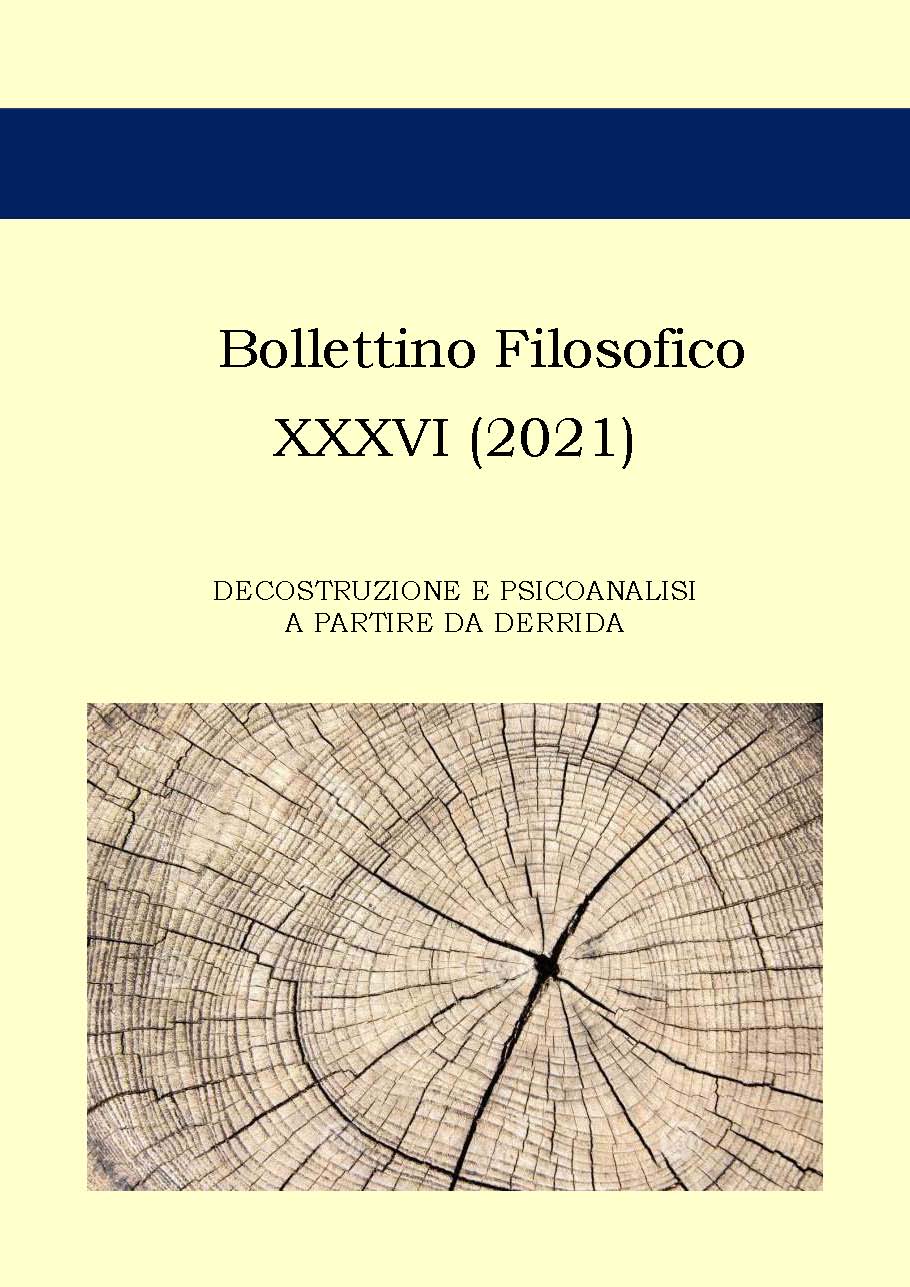
DECOSTRUZIONE E PSICOANALISI. A PARTIRE DA DERRIDA
V. 36 (2021)Nel quadro multiforme e frastagliato della seconda metà del XX secolo, in cui quasi tutti i campi del sapere hanno sperimentato fecondità e derive della contaminazione tra ambiti disciplinari, procedure metodologiche e oggetti di indagine, ha avuto particolare risonanza il paradigma derridiano della “decostruzione”. Già dal primo apparire delle opere del filosofo, movimenti tellurici di piccola o grande intensità hanno scosso la consolidata rigidità di discipline come l'antropologia, la linguistica, la critica letteraria, la storia della filosofia: le letture di Derrida, infatti, miravano a localizzare la genesi dei concetti che sostenevano i vari saperi e provavano a mostrare come l'intera architettura di tali concetti fosse meno solida o fondata di quanto la tradizione aveva creduto. Il progetto fenomenologico di Husserl, come pure il ripensamento della questione dell’essere e del suo oblio e, insieme, l’oltrepassamento (Überwindung) della metafisica teorizzato da Heidegger costituiscono il terreno su cui germinerà quella che presto verrà chiamata “decostruzione”, termine che, tra l'altro, verrà coniato proprio in riferimento alla Destruktion heideggeriana seppure con l'intento di destabilizzare le strutture concettuali della tradizione onto-teologica invece che mirare al recupero di un senso originario e obliato dell’essere. Lentamente, ma inesorabilmente, cominciavano ad apparire cedimenti categoriali, crepe testuali, scissure che intaccavano la storia della metafisica, le teorie linguistiche, ma anche la biologia o l’architettura: saperi messi alla prova nei loro fondamenti epistemologici e interrogati da prospettive oblique. Il terreno della psicoanalisi che, nello stesso volgere di anni, proprio in Francia stava vivendo il “ritorno a Freud” ipotizzato da Jacques Lacan, diverrà subito un luogo di confronto non privo di polemiche che ancora oggi, a più di cinquant'anni dal loro primo farsi strada, alimentano dibattiti e percorsi teorici. “Decostruzione” e psicoanalisi, dunque, possono essere considerati come i poli di un arco voltaico che continua a generare domande sulla costituzione del soggetto, sulla sua relazione con il mondo, su quanto viene considerato reale e sulle temporalità in cui si dispiega la coalescenza del legame sociale. Sopite le arroventate dispute e venute meno le passioni del momento che hanno visto contrapporsi Derrida e Lacan, si tratterà anzitutto di riattraversare i termini di questioni che, in ogni caso, non hanno perso il carattere di urgenza sia nell'ambito filosofico, sia in quello psicoanalitico; nel riconoscere a ciascuno degli ambiti la specificità di percorsi, occorrerà quindi, rilanciare domande che scaturiscono (o forse confluiscono) dalla più ampia questione del senso e del destino non solo di discipline e saperi ma, soprattutto, di chi se ne fa portavoce e agonista.
-

RITORNO ALLE ORIGINI. GENESI ED EVOLUZIONE DEL PENSIERO DI MARTIN HEIDEGGER
V. 35 (2020)Intorno agli anni ’20 del XX secolo, Martin Heidegger va maturando una riflessione sull’«essere» che, avvalendosi del metodo fenomenologico, darà luogo ad una nuova ontologia. Essere e tempo, pubblicato nel 1927, si presenta anche come l’esito di un processo di gestazione che nei corsi e negli appunti delle lezioni, nei testi di conferenze e nel materiale inedito che lo precedono, può ancora trovare risorse e sollecitazioni per il riattraversamento di un pensiero la cui radicalità non ha smesso di interrogare storici e filosofi. In questi anni, peraltro, appare centrale l'intreccio con alcune questioni più marcatamente teologiche (si pensi alle interpretazioni paoline o allo studio dell'antropologia agostiniana) non solo rispetto ad una più generale comprensione dell’orizzonte speculativo dell’ermeneutica heideggeriana, ma anche rispetto alla domanda circa la storicità dell'esistenza e l'irruzione del tempo kairologico nella vita effettiva (come avviene nella prima comunità cristiana), con la conseguente ridefinizione del senso dell’essere non più come semplice presenza o ousia, ma come parousia: la questione del senso si carica di una peculiare tonalità drammatica in cui aleggia la tentazione di convertire l’“inquieta preoccupazione” che caratterizza ogni vita effettiva in una metafisica “acquietante”. La progressiva ontologizzazione del lessico heideggeriano che vira dalla nozione di «vita» a quella di «essere» dopo la chiamata a Marburgo nel 1923 o che produce una più spiccata attenzione alla questione della «differenza», pone rilevanti interrogativi non soltanto riguardo a continuità o discontinuità del pensiero heideggeriano, ma anche rispetto agli “effetti” che questo pensiero ha prodotto (e continua a produrre) nel dibattito filosofico del nostro tempo. Si tratterà allora, al di là delle comunque pertinenti analisi di filologia heideggeriana, di riconsiderare il progetto teorico di un pensiero che, nelle sue prime movenze, si è interessato ai dibattiti fenomenologici come a quelli teologici, nel tentativo di comporre fratture e conflitti come, ad esempio, quello del periodo friburghese tra l’elemento fattuale della vita e la categorializzazione del vissuto, ovvero il contrasto tra la “matrice oscura” della soggettività e l’aspetto semantico o ideale o intenzionale presente nell’esistenza effettiva. La pubblicazione ormai quasi integrale dell’intera opera di Martin Heidegger (in cui, è bene rammentarlo, lo stesso filosofo è tornato più volte retrospettivamente sulla genesi del suo percorso di pensiero), permette di ripensare criticamente una produzione teorica che, come mostrano proprio gli scritti che precedono Essere e tempo, aveva assunto la dimensione storica dell’individuo come orizzonte unico dell’esperienza possibile articolata nelle forme di una fenomenologia della vita e che, lentamente e a partire da più o meno esplicite «svolte», si incamminerà verso il tentativo di oltrepassare il lessico e i concetti della metafisica tradizionale.
-
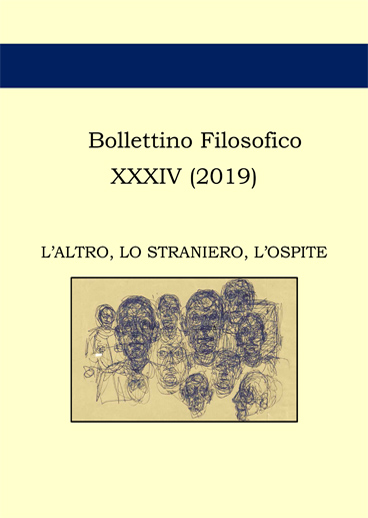
L’ALTRO, LO STRANIERO, L’OSPITE
V. 34 (2019)Se il pensiero filosofico si è interrogato sulle forme dell’alterità fin dal suo primo apparire, l’epoca contemporanea ha assistito ad una sorta di precipitazione in cui proprio tali forme si sono intrecciate con le sfide geo-filosofiche, il mutamento dei paradigmi di indagine sociale, i nuovi campi del sapere prodotti dalle scienze umane. L’accelerazione che si è prodotta ha dunque coinvolto anche la filosofia interpellata su un doppio fronte: quello propriamente teorico della formulazione o ridiscussione dei paradigmi dell’alterità sui quali si è costruita la civiltà occidentale, e quello epistemologico e metodologico in cui il pensiero interroga il suo pensare l’altro. Ma, rispetto all’attualità socio-politica e alle numerose discussioni pubbliche che la modulano, il pensiero filosofico non può esimersi dal ripensare quanto forse costituisce il suo più proprio o la sua infinita risorsa: l’altro, infatti, a partire dalle forme che assume o in cui si manifesta, si impone sempre come ingiunzione e domanda, soprattutto nel momento in cui chiede ospitalità (fosse pure dell’elaborazione teorica) o in cui appare indossando i panni di quello straniero che, secondo la parola di Michel de Certeau, è “l’irriducibile e colui senza il quale vivere non è più vivere”.
Si tratterà allora di pensare ancora una volta l’insieme di questioni teoriche ed epistemologiche che l’alterità sollecita e, insieme, occorrerà ripensare a quanto la tradizione filosofica occidentale ha prodotto nel corso della sua lunga storia ogni volta che ha incontrato (o si è scontrata) con quello straniero (espressione dell’estraneità) che ha sollecitato i suoi guadagni teorici o il suo percorso, senza escludere il versante teologico in cui, nelle varie tradizioni religiose, l’alterità si è spesso intrecciata con la trascendenza e ha prodotto riflessioni di fondamentale importanza.
Convocando voci che intrecciano la filosofia con ambiti disciplinari e metodologici della più vasta area delle scienze umane, il Bollettino Filosofico intende ripercorrere questioni antiche e nuove intorno all’altro e ai suoi volti al di là di quanto viene considerato come accertata e indiscutibile acquisizione, magari in direzione di una riflessione sulla relazione che, come ha scritto Emmanuel Levinas, “non ha misura comune con un potere che si esercita, foss’anche godimento o conoscenza”.
-

Ripensare la fenomenologia, con e oltre
V. 33 (2018)Inseparabile dal suo sviluppo storico, la fenomenologia continua a rappresentare un centrale punto diriferimento del pensiero del nostro tempo, soprattutto rispetto ai numerosi saperi che mettono indiscussione l'ipotesi di filosofia come "scienza rigorosa". La ricezione internazionale del movimento fenomenologico avviato da Husserl, nella varietà delle posizioni, ha da subito mostrato l'impossibilità di una "ortodossia" fenomenologica e forse anche l'intrinseca difficoltà di definirne un oggetto tematico specifico, mentre il problematico rapporto tra universalità delle essenze e singolarità delle esperienze ha prodotto un campo di forze teoriche che si riverbera lungo tutta la contemporaneità. Ma i dibattiti inaugurati dal metodo fenomenologico (si pensi ad esempio alla celebre rottura tra Heidegger e Husserl) hanno investito la filosofia anche e soprattutto dal punto di vista dei suoi metodi, delle sue strutture, degli schemi nei quali si è espressa e continua ad esprimersi, ed hanno per questo rimesso in discussione l'intera storia del pensiero filosofico occidentale. Interrogarsi “con e oltre” la fenomenologia, dunque, significa oggi non soltanto ripercorrerne le tappe significative o i punti di rottura rispetto alla tradizione, ma riprendere l'insieme di domande che hanno scandito la sua evoluzione e che hanno interagito, oltre che con la riflessione filosofica, con gli altri campi del sapere su cui si esercita la ragione dell'uomo.
-

Poesia e filosofia a confronto. A partire dal moderno
V. 32 (2017)Tra le domande della filosofia, quella sul rapporto tra poesia e filosofia rimette in gioco in maniera feconda entrambi i termini di tale rapporto: lo sguardo filosofico attraversa la poesia e sviluppa, a partire da essa, un discorso in cui la parola è interrogata nel suo ruolo storico e temporale attuale, per fornire di nuovo alla riflessione filosofica quello strumento, di cui essa ha bisogno e che, nell’affidarsi soltanto alle proprie argomentazioni, non riesce a trovare. Tuttavia, tra parola filosofica e parola poetica non può esserci un rapporto subordinato, ma di reciproca fiducia e conoscenza, un rapporto in cui l’una dà all'altra ciò che le manca, nel comune, infaticabile tentativo di comprendere la realtà, nonostante atteggiamenti e punti di vista differenti su di essa. In questione sarà, allora, il senso di una parola che, come la filosofia, anche la poesia frequenta, ma che, passando attraverso il filtro poetico viene trasfigurata e acquista caratteri diversi e - proprio in virtù dell’enigmatico processo di trasformazione che subisce - decisivi. Spesso la filosofia ha cercato una collocazione e una sistemazione della poesia all’interno di un quadro generale, tradendo in questo modo quella tendenza all’egemonia teorica e concettuale, che non di rado la contrassegna. Forse è venuto il tempo in cui a prevalere sia di nuovo una posizione di ascolto filosofico della parola poetica, lasciando che sia la poesia ad offrire alla filosofia ciò che essa vuole e può donare. Riprendere la domanda sul rapporto tra filosofia e poesia significa tornare a interrogarsi anche sul rapporto tra poeta e filosofo.
Se il romantico è stato il tempo in cui la poesia ha avuto un posto privilegiato al centro della riflessione filosofica, tanto che la veste di poeta-filosofo si è identificata spesso con quella di filosofo-poeta, nei decenni successivi, e nel corso del Novecento, con il mutare dei problemi e dei metodi assunti dalla filosofia, si è assistito a un analogo mutamento della poesia che, non solo nella forma, ma anche nei contenuti, è divenuta una modalità della lingua entro cui manifestare propriamente un pensiero. Sondare storicamente questo passaggio, coglierne alcune tappe nelle figure di pensatori e poeti del nostro tempo, analizzare i momenti storici e teorici che ne segnano le trame, può gettare una nuova luce su un rapporto sicuramente mutato, anche se mai realmente interrotto. Ancora: dischiudere orizzonti inesplorati nei pensatori-poeti della nostra storia vorrebbe dire accrescere le potenzialità della riflessione filosofica, considerato che anche la poesia si è avvalsa della filosofia là dove ha colto in essa quelle affinità che solo una distanza nel linguaggio ha tenuto nascoste. La sfida da raccogliere è cercare di mostrarle in una nuova luce, sia ripercorrendo la trama di alcuni momenti poetici esemplari, sia ripensando piste inedite della storia del pensiero.
-
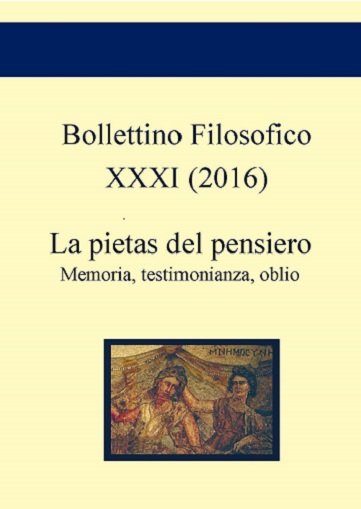
La pietas del pensiero. Memoria, testimonianza, oblio
V. 31 (2016)Parlare di “pietas del pensiero” può sembrare, oggi più che mai, richiamarsi ad una non meglio precisata “religiosità”, ad una “devozione” capace di porre fine allo smarrimento che attraversa, come un fiume carsico, la realtà e il pensiero che prova a farsene carico. Ma fare appello alla pietas può anche voler dire, per il pensiero, tornare al suo originario compito che consiste nell'interrogare il presente, il mondo, l'uomo attraverso la memoria e la testimonianza, come pure attraverso l'oblio che della memoria e della testimonianza è insieme deriva e occulta risorsa.
La storia del pensiero filosofico, pur nella varietà delle dissomiglianze, si è sempre interrogata sul senso del suo proprio lavoro, e per questo si è spesso ritrovata nella necessità di “rendere ragione” (nel senso letterale dell'espressione) del suo fare memoria (come implicato dall'idea di tradizione), del suo farsi testimonianza interrogandone il concetto e le forme, della sua lotta contro l'oblio che è causa del risorgere di antiche violenze o del ritorno di fatali ideologie.
L'attualità di tali questioni interseca o intercetta dibattiti che investono la realtà dell'Europa sotto il profilo culturale, filosofico, sociale e politico e impone al pensiero di riconfigurarsi alla luce delle nuove sfide che si affacciano all'orizzonte (basti pensare, per fare solo due esempi, alla densità teorica assunta dal problema del “perdono” in relazione alla storia, o al problema degli archivi e della memoria nel dominio del virtuale).
-
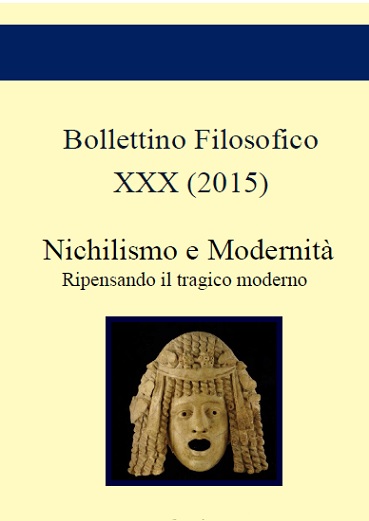
Nichilismo e Modernità. Ripensando il tragico moderno
V. 30 (2015)«Con il sapere tragico ha inizio il movimento della storia»: così Karl Jaspers riflette sulla genesi della civiltà umana. La tragicità del sapere storico giunge a consapevolezza attraversando il problema dei limiti del senso e quello correlato del “nulla”. La questione del nichilismo affonda le sue radici in questo terreno speculativo rappresentando una risposta, polimorfa e moderna, a problemi antichi.
Il nichilismo, un evento culturale controverso, da taluni definito “anima profonda della modernità” è spesso utilizzato come accusa filosofica per screditare gli avversari sul piano logico e su quello morale. A partire da Nietzsche, è diventato un termine di confronto importante per numerosi pensatori, che hanno visto in esso, di volta in volta, un transitorio decadimento della razionalità umana o l’inevitabile esito del fato postmoderno, al punto che Wilhelm Weischedel ha ritenuto di definire il pensiero contemporaneo come un filosofare all’«ombra del nichilismo».
Il “Bollettino Filosofico” si propone di rilanciare il dibattito sul rapporto tra “nichilismo e modernità” per sondarne le attuali declinazioni nelle diverse aree disciplinari e nei diversi ambiti (etico, estetico, gnoseologico, politico e religioso), alla luce dell’urgenza con la quale i problemi della crisi di senso, fondamenti e valori si manifestano nel sentire contemporaneo, nell’intento sia di focalizzare la pluralità di forme che suscita la riflessione su un tema così ampio, sia di individuare le piste ancora inesplorate del dibattito contemporaneo su questo tema.
-
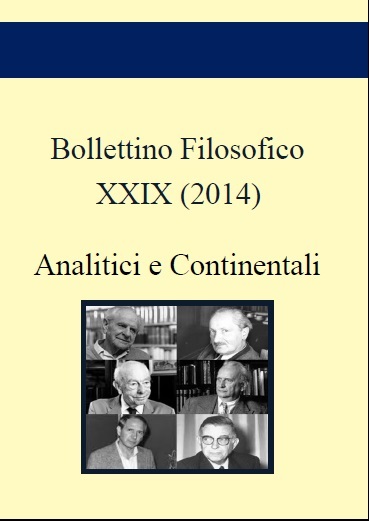
Analitici e Continentali
V. 29 (2014)Il dibattito filosofico attuale registra fedelmente le mutazioni della società contemporanea e manifesta le sue stesse frantumazioni, specialismi, difficoltà di dialogo che talvolta sembrano sfiorare l’incomunicabilità. In una simile congiuntura le categorizzazioni teoretiche e storiografiche, oltre a rispondere al bisogno di “mettere ordine” nel dibattito, possono rappresentare una preziosa occasione per rilanciarlo, vivificarlo e trasformarlo, rendendo visibili differenze e affinità tra le varie posizioni in gioco e dischiudendo, attraverso il confronto e il dialogo, nuovi orizzonti teorici e possibilità di pensiero.
La distinzione tra analitici e continentali rappresenta un decisivo punto di riferimento storiografico e teorico, dal quale prendere le mosse per orientarsi in uno scenario estremamente complesso in cui si intrecciano, con l’opposizione e il dialogo, anche sofisticate forme di contaminazione tra tradizioni filosofiche. A quindici anni di distanza dalla pubblicazione del volume di Franca D’Agostini, Analitici e continentali, che proponeva un inventario di questo fondamentale confronto, il “Bollettino” intende ripensare nel suo complesso la questione alla luce delle diverse sensibilità filosofiche con le quali gli studiosi europei, americani e di altre aree geografiche affrontano tale argomento. Di qui l’idea di dedicare ad analitici e continentali il numero della rivista, nell’intento di redigere un bilancio critico e di proporre una visione d’insieme dell’attualità filosofica e delle genealogie che ne costituiscono lo sfondo storico. -

Croce tra passato e futuro
V. 28 (2013)Il presente volume non intende essere affatto celebrativo o commemorativo della figura di Benedetto Croce, prendendo spunto dal sessantesimo anniversario della sua scomparsa. Egli stesso non amava le occasioni celebrative e detestava gli anniversari, cui opponeva l'impegno quotidiano nel lavoro.
Siamo certamente lontani dalla temperie culturale degli anni sessanta e settanta, quando ancora prevalevano alcuni vecchi stereotipi e pregiudizi verso la filosofia di Croce: epigono dell'hegelismo, rappresentante della vecchia tradizione retorica italiana, facile solutore di “enigmi” filosofici, olimpico osservatore dei drammi della storia, nemico delle scienze e della cultura scientifica, fautore di conservatorismo culturale e politico… Tra la fine degli anni settanta e i primi anni ottanta, a poco a poco, apparvero invecchiate le antiche polemiche e si riprese a parlare di un “ritorno di Croce” nella cultura italiana, senza avvertire più la necessità - come aveva asserito, alcuni decenni prima, Gianfranco Contini – di «riuscire post-crociani senza essere anticrociani». Certo non a caso, tra gli inizi e la fine degli anni ottanta, apparvero volumi dal titolo Ritorno a Croce o dal titolo Il ritorno di Croce nella cultura italiana.
Resta poi da chiedersi se si possa parlare effettivamente di un “ritorno di Croce” negli ultimi due decenni. In realtà, una “moda” crociana non c’è e non c’è stata recentemente, per di più non poteva esserci. A riguardo ha perfettamente ragione Paolo Bonetti, quando ha osservato nella sua Introduzione a Croce per i tipi della Laterza: «Comunque lo si voglia giudicare, Croce è un pensatore moralmente troppo severo per diventare oggetto di moda. Ma è proprio questa “severità” (che non ha nulla a che vedere con il moralismo dei retori, da lui sempre detestato) a rendere paradossalmente possibile una nuova presenza di Croce, per tutti coloro, almeno, che si ostinano, in ogni campo del sapere, a pensare i problemi nella loro specificità e determinatezza storica».
Sta di fatto che, nell'ultimo trentennio, si sono riprese a stampare per i tipi della casa editrice Adelphi, a cura di Giuseppe Galasso, alcune tra le più importanti opere crociane, ed è stato pubblicato un numero cospicuo di volumi nella Edizione Nazionale delle opere di Benedetto Croce, curata dall’editore Bibliopolis di Napoli.
Infine, convegni e altre iniziative scientifiche e culturali hanno cominciato a riproporre in certa misura il filosofo e temi legati al suo pensiero, in Italia e all’estero. Si pensi agli studi stranieri degli ultimi due o tre decenni, ad opera di D.D. Roberts, C. Boulay, R. Zimmer, K. Acham, R. Bellamy, R. Wellek, K. E. Lönne, M. Moss, J. Kelemen, M. Kaposi, solo per citarne alcuni.
Se in alcuni paesi stranieri, come negli Stati Uniti d'America, si è progressivamente risvegliato l'interesse per la figura e l'opera di Benedetto Croce, in Italia, d'altro canto, al lento declino di alcune mode esterofile è via via corrisposta una rinnovata attenzione per la tradizione filosofica del nostro Paese.
Sarebbe certamente un compito arduo tracciare una panoramica, sia pure generalissima, delle alterne fortune del crocianesimo negli ultimi decenni: ciò implicherebbe approfondite escursioni nei diversi ambiti di storia delle idee, di storia della cultura, della storiografia filosofica, della tradizione storicistica e di quella idealistica e delle loro reciproche implicazioni teoretiche. Ma non è tale l'intento di questa breve nota introduttiva. L'invito rivolto a studiosi italiani e stranieri a ripensare in maniera critica e problematica importanti temi della riflessione crociana ha avuto piuttosto lo scopo di considerare una possibile riattualizzazione di un pensiero che, come tutti i classici, non è solo consegnato al passato, ma ha ancora qualcosa da dire per il tempo a venire; da qui il titolo del presente numero monografico della rivista: “Croce tra passato e futuro”.
Non pochi studiosi, di diversa formazione ed orientamento, hanno risposto prontamente a tale invito: da Paolo Bonetti a Romeo Bufalo, a Giuseppe Cacciatore, a Giuseppe Cantillo, a Salvatore Cingari, a Daniela Coli, a Domenico Conte, a Girolamo Cotroneo, a Maria Della Volpe, a Giuseppe Gembillo, a Giuseppe Giordano, a Giovanni Invitto, a Fabrizio Lomonaco, a Eduardo Massimilla, a Aniello Montano, a Myra Moss, a Ernesto Paolozzi, a Rosalia Peluso, a David Roberts, a Emilia Scarcella, a Fulvio Tessitore, a Aldo Trione, a Renata Viti Cavaliere.
La loro attenzione critica si è concentrata maggiormente sui temi fondamentali del pensiero crociano, proposti nell'iniziale Call for papers: dalla teoria della storia alla problematica etica, a quella estetica, al rapporto tra filosofia e scienza e scienze della cultura, alla questione della “religiosità”, al tema dell'esistenza, ai rapporti di Croce con lo storicismo tedesco, a confronti e paralleli con pensatori italiani e stranieri.
Va segnalato che in non pochi contributi presenti nel volume, un'attenzione particolare è rivolta - oltre che alle tematiche centrali del crocianesimo - ad alcune questioni che nel passato erano rimaste oscurate da un cono d'ombra, perché ritenuti “minori” rispetto a questioni legate allo storicismo e all'idealismo proto-novecentesco: mi riferisco, in particolare, ai temi dell' “ultimo Croce”: la questione della “vitalità”, il ripensamento del rapporto tra esistenza e storia, l'interesse per quelle problematiche legate a una “religiosità” vissuta e sofferta, e così via.
Nel licenziare il volume alla stampa, desidero ringraziare tutti i colleghi italiani e stranieri che hanno contribuito al presente numero del “Bollettino Filosofico”, nonché i componenti della redazione della rivista per il lavoro di editing generosamente profuso.
